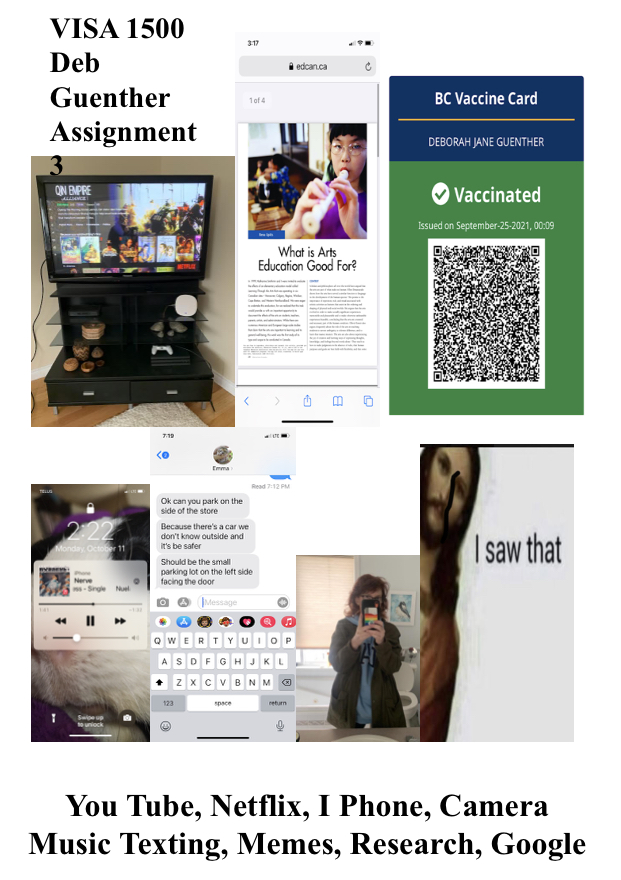Image Attribution: “Social Networking Sites” by Debbie Guenther is licensed under CC BY-SA. (See interactive map)
Debbie Guenther
Prof. Teryl Atkins
VISA 1500
October 23,2021
Assignment 3 Part A
In December 2013, the purchase of an iPhone 5C for each member of the Guenther family, began a journey that changed the foundation of the family structure and introduced a new entity into what had a been secure, predictable 5-person unit. The introduction of this portable telephone, camera, computer, now enabled each person to communicate, observe privately, listen to their own music, game any genre, and view any material of choice. The world wide web became the biggest and most predatory playground, and it was now the newest member of the Guenther family, forever. The impact that technology not only effected this small family unit but has infiltrated everyone, ever culture, young or old, rich, or poor it is a global condition that has both negative and positive reputation but either way there’s no going back to analogue.
Beginning with Facebook, which is an old person’s platform, was useful as a means of digitally communicating with a select group of friends, selling and buying things, a search engine to locate people and to read the news. It became a familiar, comfortable arena for individuals who weren’t very computer savvy to navigate. Until it became unsafe, a tool to invade privacy and an invisible observer of our online behavior and habits. On September 15, 2018, Facebook decided not to inform its 50 million subscribers that their personal information had stolen, beginning a new reality that privacy is an illusion and online platforms are not your friend, they are a business (Cyber.gc.ca Online web).
Next YouTube, an online platform that allows access to a plethora of information, just type and search on ANY topic and an offering of visual media is at your feet. The impact of online video has not only influenced an entire generation of people but its effect on children is still being studied. Sophie Boerman along with Eva Reijmersdal, discuss how You Tubes marketing agenda has trained and taught children to brand recall, and to recognize and associate online personalities and product in a personal, relational way. This allows advertisers to grow a client base that will recognize and buy their product, Boerman and Reijmersdal states that “…these influencers often embed persuasive sponsored messages in their videos to earn money” as well as, “…children between 8 and 12 years old showed that, when children correctly recalled the disclosure, the disclosure increased their recognition of advertising and understanding of selling and persuasive intent…enhance[ing] brand memory through Ad recognition”(1). YouTube has become an effective tool to influence our youth as a future consumer generation. However, YouTube does have some notable benefits as an educational resource, a global communication interface, and source for entertainment.
The greatest indulgence for entertainment recently has been Netflix. In the in the past year the need for immediacy of any movie or program, when the mood strikes, has evolved from waiting for the program to air on TV to the need for instant viewership anytime, anyplace. In an article written by Oliver Budziski, Sandra Gaenssle and Nadine Lindstadt-Dreusucke they analyze how audiovisual markets like Netflix, YouTube, Amazon Prime are all chasing after the same space and dollar. They state that “…the world of audiovisual online markets [are] rapidly changing…” and “…competition interrelations between such different formats such as traditional TV, videos on YouTube, and streaming via Netflix are subject to controversy “(Budzinski 1). With such fierce competition for people’s attention (gaze) the entertainment viewing platforms will only become more dominant and competitive trending toward a future where a complete obliteration of traditional media like TV will become a novelty like the record player.
This year, during the covid crisis, personal usage of media for entertainment, communication, research, and the camera became a lifeline to the outside world. In the last 4 days, October 22 – 26, 2021, an example of personal usage of social networking sites, within a 12-hour period from 8 am -11 pm, was up to 4 – 5 hours of that day. Entertainment platforms taking a greater bite of time like Netflix and/or You Tube, with an average of 3.5 hours in the evening. Texting and emailing, at least 1 hour a day and depending on the level of research necessary for school, google was also 1 – 2 hours per day in this snapshot week. To be noted while watching Netflix, texting, and searching the internet through google and You Tube were often done at the same time as watching Netflix. Noticing patterns of usage were linked to time of day and other obligations that required hands on attention. Budzinski confirms that point by stating “…characteristics of demand [depends] on, for whom (e.g., age groups); during what time of the day (e.g., prime time); and for what purposes (e.g., genre, motivation/intention)” (22). There was a correlation between the time of day each media platform was accessed and the reason for the access, work or fun. Resulting in an increase of isolated personal time using media and less of a desire or need to talk to family members effecting quality of human interpersonal relationships. A negative indeed.
Works Cited
Boerman, Sophie C. and Eva A, van Reijmersdal. “Disclosing Influencer Marketing on YouTube to Children: The Moderating Role of Para-Social Relationship.” Frontiers in Pschology (January 21. 2020): 1 -15. Article 3024, Vol. 10.
Budzinski, Oliver et. al. “The Battle of YouTube , TV and Netflix: an Empirical Analysis of Competition in Audiovisual Media Markets.” SN Business & Economics (August 2021): 1 – 26. DOI: org/10.1007/s43546-021-00122-0.
Government of Canada. Cyber.gc.ca. 03 October 2018. Online. 23 October 2021.
